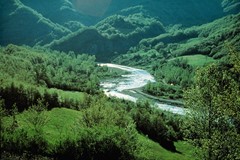Municipality of Vetto.
The Rio Tassaro Valley amid nature and medieval villages
Lying in the Apennine range near Reggio Emilia, Vetto has ancient origins dating back to the Roman era. We have a mention of the village from 1142 where the church of San Lorenzo is cited. The same century, the former "Vectum", which had meanwhile passed from the hands of the Canossa family to a feudal family called Da Palude, was the subject of controversy between the Bishops of Parma and Reggio Emilia. In 1315, it was destroyed by the forces of the Commune of Reggio who decreed that it could not be rebuilt, however this disposition was ignored and it subsequently became a Commune under the jurisdiction of Castelnovo nè Monti.
The current village preserves some interesting monuments such as the Church of San Lorenzo from the Romanesque period, but rebuilt from the foundations midway through the XVII century. During the visit of Bishop Marliani in 1664 it was said to be "ancient and liturgically oriented". It features a fine bell tower with a twin-lancet-window, a sandstone portal with split frontispiece set on columns, fashioned sandstone windows and an ashlar bearing the date "1670". Recent restoration brought to the light some fragments of a sandstone cornice decorated with leaf motifs attributed to the early XII century. Of note is the "Osteria del Turo", a sturdy tower house from the XVII century with an adjacent courtyard reached through an ample round-arched portal. Nearby are remarkable ruins of an even older tower whose narrow windows may still be made out. A second grand tower house of a type common in the XVI-XVII centuries sits at the western edge of the village and is flanked by an ancient courtyard again with a round-arched portal.
The village rises from a natural balcony that overlooks the River Enza; the landscape is beautiful, with that gentleness that is fully in harmony with the individuality of the Middle Apennines, a gentleness that is never monotonous however, thanks to some geological roughness and some unexpected glimpses of the horizon made more striking by the outline of the castles. The nearby Rio Tassaro Valley, whose history is intimately linked to that of the Grand Countess Matilda, has been acknowledged by the European Union as an Area of Community Interest, and offers several routes for excursions along the ancient medieval mule tracks, which pass through oak and chestnut woods where large trees still survive, such as the monumental chestnut tree at the medieval village of Spigone. Fans of trekking can follow the enchanting Sentiero dei Ducati which crosses the Apennines to reach the Tyrrhenian coast. One must is to go on a hunt for the countless little villages, with their untouched ancient architecture, that dot the countryside of the Municipality of Vetto.
In the village of Crovara, lying to the left of the Tassobbio mountain stream, once sat the medieval fortress of the Da Palude Counts, which was first mentioned in 1270. It was destroyed and rebuilt several times because of the interminable struggles between the Guelphs and the Ghibellines. Today only a few ruins remain, however two galleries are still visible, as well as a massive piece of walling and the foot of a four-metre tall tower. The nearby Church of San Giorgio houses a priceless “Annunciation” from the school of Guercino as well as a remarkable Baroque tabernacle in gilded wood. The sacristy is enclosed in an adjacent wall inside a large stone cylinder, part of the castle’s dry-stone wall, on which the mocking face of a devil has been sculpted. Just a kilometre from the fortress we come across the village of Legoreccio whose remarkable monumental heritage has an inspired setting in a one-off natural frame against a background of centuries-old chestnut woods and swathes of forest. Here we can still find several tower houses, one of which functioned as the customs house between the States of Parma and Modena until 1821. Of note is the building which was home to the Da Palude family; this is one of the most fascinating patrician dwellings in the mountains of Reggio Emilia. The closed court overlooks a courtyard with double loggia and includes a fine oratory dating back to the seventeenth century. Also the village of Pineto features buildings of ancient origin, dominated by a tower house with a beautiful rose window on its façade. Here is another Da Palude palace which features an open gallery with two principal orders, and small columns bearing round arches.
The visit can continue to take in other characteristic sites such as Spigone, Santo Stefano and Castellaro.
